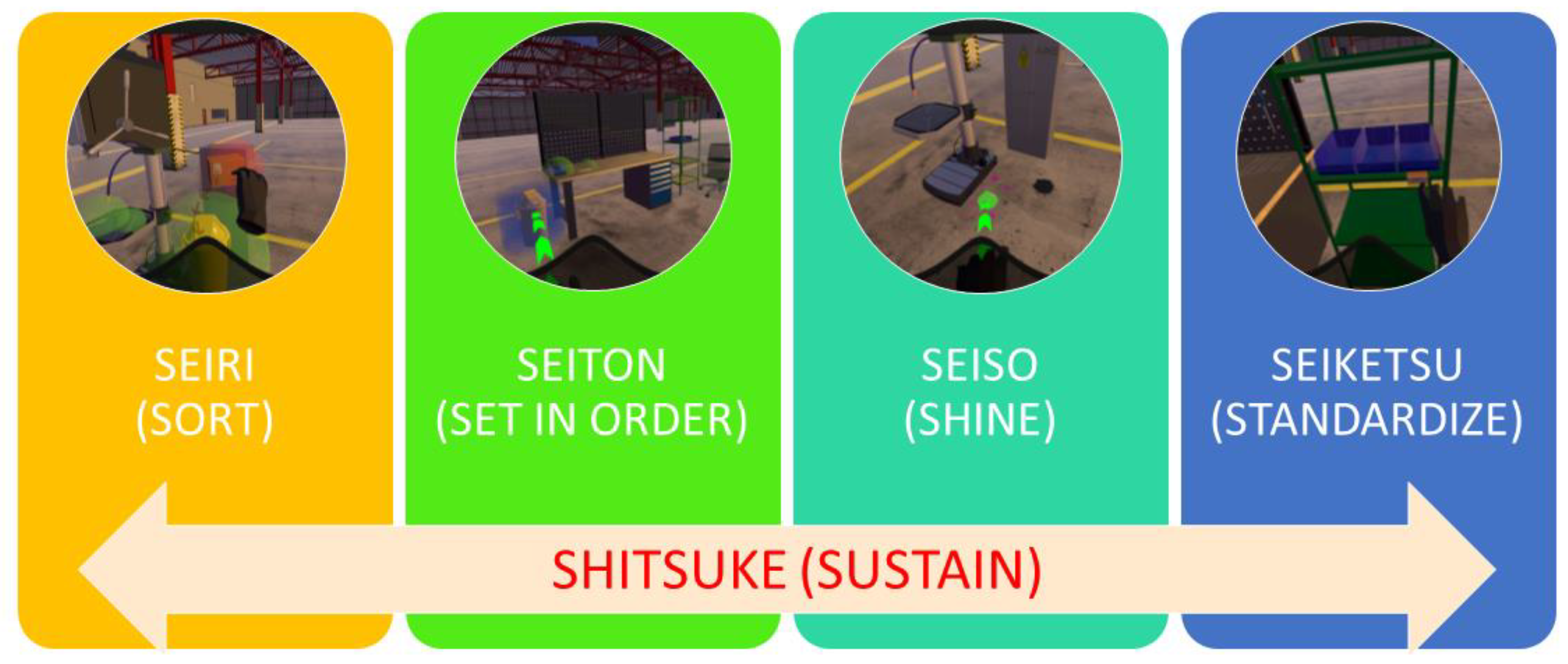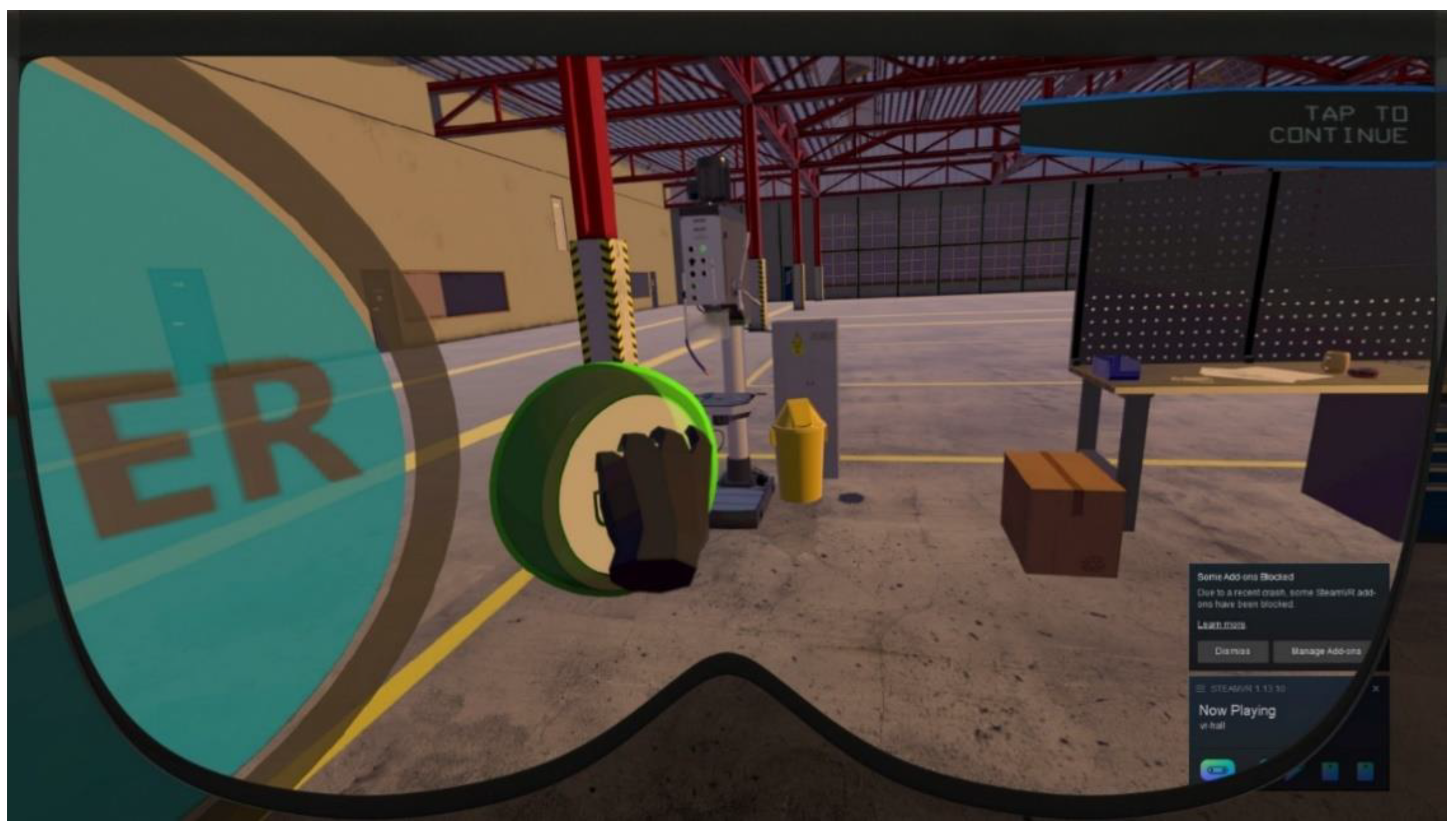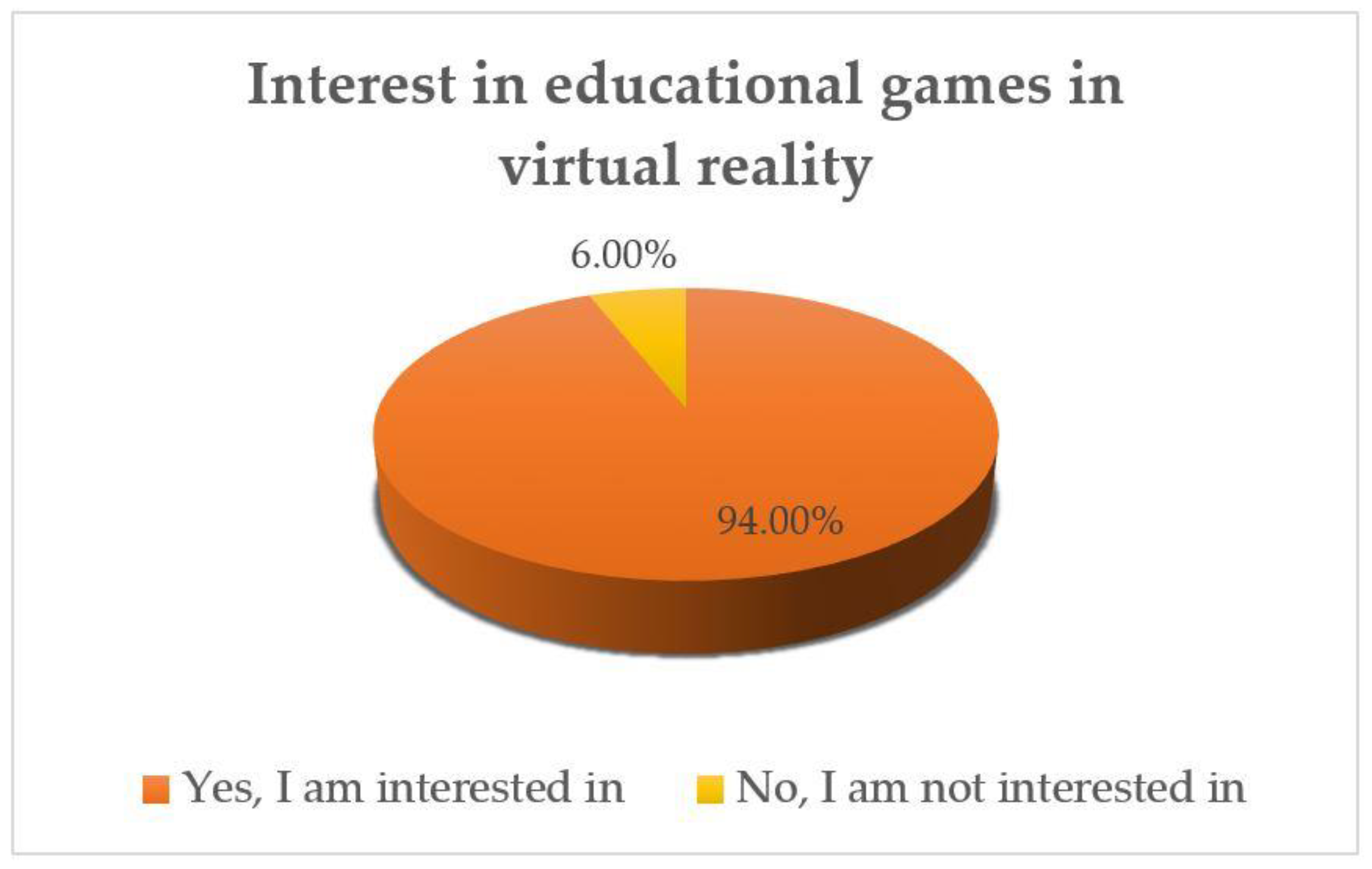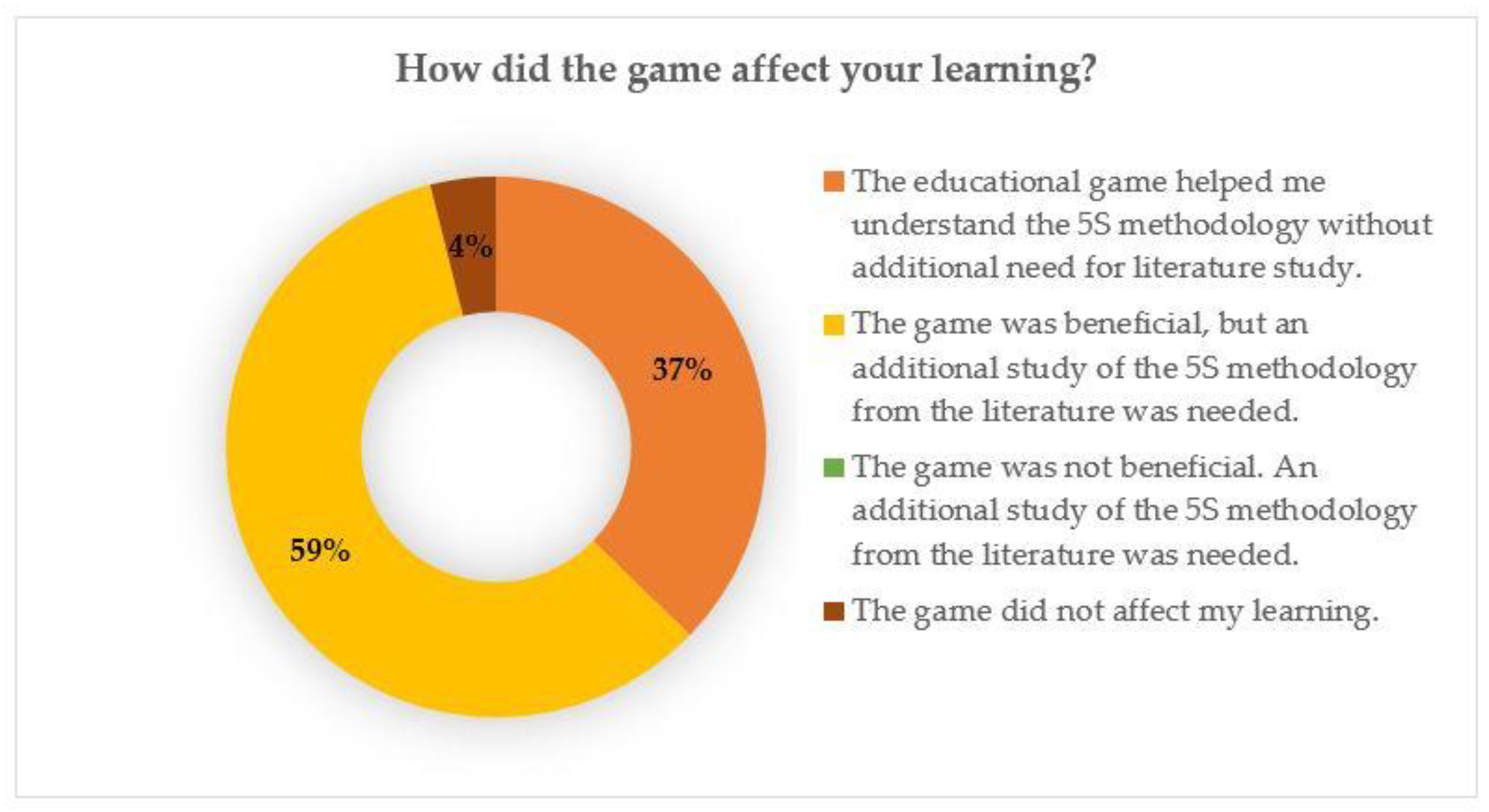A Case Study of Educational Games in Virtual Reality as a Teaching Method of Lean Management
Abstract
1. Introduction
2. Previous Research
Theoretical Basis for Creating a 5S Educational Game in Virtual Reality
3. Materials and Methods
3.1. Case Study
- Research question 1: Are educational games an attractive teaching method for university students?
- Research question 2: Do educational games bring benefits to the teaching process? If so, what are they?
- Research question 3: Could educational games help students to better understand the subject?
- Research question 4: Could educational games increase the students’ ability to learn on their own?
3.2. Technical Basis for Creating an Educational Game
4. Results
4.1. Educational Game—Workflow
4.1.1. Level 0—Start
4.1.2. Level 1—Seiri (Sort)
4.1.3. Level 2—Seiton (Set in Order)
4.1.4. Level 3—Seiso (Shine)
4.1.5. Level 4—Seiketsu (Standardize)
4.1.6. Level 5—Shitsuke (Sustain)
4.1.7. The Scoring System
4.2. Results—Phase One
4.3. Results—Phase Two
5. Conclusions
Author Contributions
Funding
Data Availability Statement
Conflicts of Interest
References
- Fifeková, E.; Nemcová, E. Industry 4.0 and Its Implications for EU Industrial Policy. In Forecasting Works (Prognostické Práce); Institute for forecasting, Slovak academy of Science: Bratislava, Slovakia, 2016; Volume 8. [Google Scholar]
- Horejší, P.; Polcar, J.; Rohlíková, L. Digital Factory and Virtual Reality: Teaching Virtual Reality Principles with Game Engines. In Virtual Learning; Cvetkovic, D., Ed.; IntechOpen: London, UK, 2016. [Google Scholar]
- Gregor, M.; Hercko, J.; Grznar, P. The factory of the future production system research. In Proceedings of the 2015 21st International Conference on Automation and Computing (ICAC), Glasgow, UK, 11–12 September 2015; IEEE: Glasgow, UK, 2015; pp. 1–6. [Google Scholar] [CrossRef]
- Gregor, M. The Future Business Will Only Be Digital (Budúci Biznis Bude Len Digitálny). TREND Inovácie Digit. 2015, 47–48. Available online: https://online.fliphtml5.com/buin/yalr/#p=1 (accessed on 9 February 2021).
- Grabinger, R.S.; Dunlap, J.C. Rich environments for active learning: A definition. Res. Learn. Technol. 2011, 3. [Google Scholar] [CrossRef]
- Lee, J.; Hammer, J. Gamification in education: What, how, why bother? Acad. Exch. Q. 2011, 15, 146. [Google Scholar]
- Liu, I.-F. The Study of Intention to Learn in Game-Based Learning with a Smartphone. Int. J. Distance Educ. Technol. 2020, 18, 25–41. [Google Scholar] [CrossRef]
- Putz, L.-M.; Hofbauer, F.; Treiblmaier, H. Can gamification help to improve education? Findings from a longitudinal study. Comput. Hum. Behav. 2020, 110, 106392. [Google Scholar] [CrossRef]
- Laganà, A.; Gervasi, O.; Tasso, S.; Perri, D.; Franciosa, F. The ECTN Virtual Education Community Prosumer Model for Promoting and Assessing Chemical Knowledge. In Computational Science and Its Applications—ICCSA 2018; Gervasi, O., Murgante, B., Misra, S., Stankova, E., Torre, C.M., Rocha, A.M.A.C., Taniar, D., Apduhan, B.O., Tarantino, E., Ryu, Y., Eds.; Springer International Publishing: Cham, Switzerland, 2018; Volume 10964, pp. 533–548. [Google Scholar] [CrossRef]
- Lee, H.; Jung, T.H.; Tom Dieck, M.; Chung, N. Experiencing immersive virtual reality in museums. Inf. Manag. 2020, 57, 103229. [Google Scholar] [CrossRef]
- Carbonell-Carrera, C.; Saorin, J.L.; Hess-Medler, S. A Geospatial Thinking Multiyear Study. Sustainability 2020, 12, 4586. [Google Scholar] [CrossRef]
- Gervasi, O.; Ranon, R. Guest editors’ foreword to the second issue on virtual reality in scientific application. Virtual Real. 2010, 14, 153. [Google Scholar] [CrossRef]
- Gervasi, O.; Magni, R.; Riganelli, M. Mixed Reality for Improving Tele-Rehabilitation Practices. In Computational Science and Its Applications—ICCSA 2015; Gervasi, O., Murgante, B., Misra, S., Gavrilova, M.L., Rocha, A.M.A.C., Torre, C., Taniar, D., Apduhan, B.O., Eds.; Springer International Publishing: Cham, Switzerland, 2015; Volume 9155, pp. 569–580. [Google Scholar] [CrossRef]
- Pedram, S.; Palmisano, S.; Skarbez, R.; Perez, P.; Farrelly, M. Investigating the process of mine rescuers’ safety training with immersive virtual reality: A structural equation modelling approach. Comput. Educ. 2020, 153, 103891. [Google Scholar] [CrossRef]
- Chen, Y.-L.; Hsu, C.-C. Self-regulated mobile game-based English learning in a virtual reality environment. Comput. Educ. 2020, 154, 103910. [Google Scholar] [CrossRef]
- Kang, H.; Kim, J. A Study on Design and Case Analysis of Virtual Reality Contents Developer Training based on Industrial Requirements. Electronics 2020, 9, 437. [Google Scholar] [CrossRef]
- Kim, J.-Y.; Nam, S. A Study of Immersive Game Contents System Design and Modeling for Virtual Reality Technology. Int. J. Control. Autom. 2014, 7, 411–418. [Google Scholar] [CrossRef]
- Yoon, J.; Kim, J. Design and implementation of invention learning curriculum-based serious game contents. New Rev. Hypermedia Multimed. 2019, 25, 205–221. [Google Scholar] [CrossRef]
- Ganebnykh, E.; Altsybeeva, I.; Gurova, E. Game based learning of lean manufacturing: Decreasing personnel resistance. SHS Web Conf. 2017, 35, 1029. [Google Scholar] [CrossRef]
- Badurdeen, F.; Marksberry, P.; Hall, A.; Gregory, B. Teaching Lean Manufacturing With Simulations and Games: A Survey and Future Directions. Simul. Gaming 2010, 41, 465–486. [Google Scholar] [CrossRef]
- Bruner, J. The Process of Education; Harvard University Press: Cambridge, MA, USA, 1960. [Google Scholar]
- Hajduk, M.; Heretik, A.; Vaseckova, B.; Forgacova, L.; Pecenak, J. Prevalence and correlations of depression and anxiety among Slovak college students. BLL 2019, 120, 695–698. [Google Scholar] [CrossRef] [PubMed]
- Hajdúk, M.; Dančík, D.; Januška, J.; Svetský, V.; Straková, A.; Turček, M.; Vašečková, B.; Forgáčová, Ľ.; Heretik, A.; Pečeňák, J. Psychotic experiences in student population during the COVID-19 pandemic. Schizophr. Res. 2020, 222, 520–521. [Google Scholar] [CrossRef] [PubMed]
- García-Lázaro, I.; Conde-Jiménez, J.; Colás-Bravo, P. Análisis de las necesidades formativas del tutor universitario de prácticas externas desde la perspectiva del self-study. Rev. Iberoam. Educ. 2020, 82, 121–140. [Google Scholar] [CrossRef]
- Colás-Bravo, P.; Rossi, P.G.; De Pablos-Pons, J.; Conde-Jiménez, J.; Moreno, P.V. Aplicaciones digitales para la inclusión. El proyecto europeo DEPIT. Rev. Comun. SEECI 2019, 169–192. [Google Scholar] [CrossRef]
- Štefánik, A.; Grznár, P.; Mičieta, B. Tools for continual process improvement—Simulation and benchmarking. In Proceedings of the 14th International Symposium of the Danube-Adria-Association-for-Automation-and-Manufacturing, Sarajevo, Bosnia & Herceg, 22–25 October 2003; pp. 443–444. [Google Scholar]
- Bhasin, S.; Burcher, P. Lean viewed as a philosophy. J. Manuf. Technol. Manag. 2006, 17, 56–72. [Google Scholar] [CrossRef]
- Mayr, A.; Weigelt, M.; Kühl, A.; Grimm, S.; Erll, A.; Potzel, M.; Franke, J. Lean 4.0—A conceptual conjunction of lean management and Industry 4.0. Procedia CIRP 2018, 72, 622–628. [Google Scholar] [CrossRef]
- Logesh, B.; Balaji, M. Experimental Investigations to Deploy Green Manufacturing through Reduction of Waste Using Lean Tools in Electrical Components Manufacturing Company. Int. J. Precis. Eng. Manuf. Technol. 2020, 8, 365–374. [Google Scholar] [CrossRef]
- Kucheryavenko, S.A.; Chistnikova, I.V.; Thorikov, B.A.; Nazarova, A.N. Adaptation of lean production tools to educational activities of universities. Práxis Educ. 2019, 15, 687–705. [Google Scholar] [CrossRef]
- Sásik, R.; Haluška, M.; Madaj, R.; Gregor, M.; Grznár, P. Development of the Assembly Set for the Logistic Transport Solution. In The Latest Methods of Construction Design; Dynybyl, V., Berka, O., Petr, K., Lopot, F., Dub, M., Eds.; Springer International Publishing: Cham, Switzerland, 2016; pp. 81–86. [Google Scholar] [CrossRef]
- Bučková, M.; Skokan, R.; Fusko, M.; Hodoň, R. Designing of logistics systems with using of computer simulation and emulation. Transp. Res. Procedia 2019, 40, 978–985. [Google Scholar] [CrossRef]
- Fusko, M.; Rakyta, M.; Dulina, L.; Sulirova, I.; Edl, M. Digitization in the technical service management system. MM Sci. J. 2018, 2018, 2260–2266. [Google Scholar] [CrossRef]
- Vavrík, V.; Gregor, M.; Grznár, P.; Mozol, Š.; Schickerle, M.; Ďurica, L.; Marschall, M.; Bielik, T. Design of Manufacturing Lines Using the Reconfigurability Principle. Mathematics 2020, 8, 1227. [Google Scholar] [CrossRef]
- Veres Harea, C.; Marian, L.; Moica, S.; Al-Akel, K. Case study concerning 5S method impact in an automotive company. Procedia Manuf. 2018, 22, 900–905. [Google Scholar] [CrossRef]
- Sharma, K.M.; Lata, S. Effectuation of Lean Tool “5S” on Materials and Work Space Efficiency in a Copper Wire Drawing Micro-Scale Industry in India. Mater. Today Proc. 2018, 5, 4678–4683. [Google Scholar] [CrossRef]
- Omogbai, O.; Salonitis, K. The Implementation of 5S Lean Tool Using System Dynamics Approach. Procedia CIRP 2017, 60, 380–385. [Google Scholar] [CrossRef]
- Jiménez, M.; Romero, L.; Domínguez, M.; Espinosa, M.D.M. 5S methodology implementation in the laboratories of an industrial engineering university school. Saf. Sci. 2015, 78, 163–172. [Google Scholar] [CrossRef]
- Sara Abdalrazig, S.; Abdelmutalab, A. Evaluating the effectiveness of 5S implementation in the industrial sector. Int. J. Innov. Sci. Res. Technol. 2019, 4, 804–808. [Google Scholar]
- Lean Six Sigma Definition. Available online: https://www.leansixsigmadefinition.com/ (accessed on 13 August 2020).
- 5S. Available online: https://www.leansixsigmadefinition.com/glossary/5s (accessed on 3 September 2020).



















| Indicate for Each Statement How Much You Agree with It: | I Totally Disagree | I Do Not Agree | I Do Not Know | I Agree | I Totally Agree |
|---|---|---|---|---|---|
| I am interested in educational games at school. | 0/0% | 6/5.3% | 3/2.6% | 81/71.1% | 24/21.0% |
| I would like to use educational games more often. | 9/7.9% | 3/2.6% | 6/5.3% | 31/27.2% | 65/57.0% |
| Educational games have no place in school. | 57/50.0% | 42/36.9% | 14/12.3% | 1/0.8% | 0/0% |
| Educational games increase student motivation. | 2/1.7% | 25/21.9% | 18/15.8% | 69/60.6% | 0/0% |
| Educational games support students’ creativity. | 3/2.6% | 10/8.8% | 6/5.3% | 86/75.4% | 9/7.9% |
| Educational games are easy to understand and use. | 0/0% | 3/2.6% | 16/14.0% | 59/51.8% | 36/31.6% |
Publisher’s Note: MDPI stays neutral with regard to jurisdictional claims in published maps and institutional affiliations. |
© 2021 by the authors. Licensee MDPI, Basel, Switzerland. This article is an open access article distributed under the terms and conditions of the Creative Commons Attribution (CC BY) license (https://creativecommons.org/licenses/by/4.0/).
Share and Cite
Krajčovič, M.; Gabajová, G.; Furmannová, B.; Vavrík, V.; Gašo, M.; Matys, M. A Case Study of Educational Games in Virtual Reality as a Teaching Method of Lean Management. Electronics 2021, 10, 838. https://doi.org/10.3390/electronics10070838
Krajčovič M, Gabajová G, Furmannová B, Vavrík V, Gašo M, Matys M. A Case Study of Educational Games in Virtual Reality as a Teaching Method of Lean Management. Electronics. 2021; 10(7):838. https://doi.org/10.3390/electronics10070838
Chicago/Turabian StyleKrajčovič, Martin, Gabriela Gabajová, Beáta Furmannová, Vladimír Vavrík, Martin Gašo, and Marián Matys. 2021. "A Case Study of Educational Games in Virtual Reality as a Teaching Method of Lean Management" Electronics 10, no. 7: 838. https://doi.org/10.3390/electronics10070838
APA StyleKrajčovič, M., Gabajová, G., Furmannová, B., Vavrík, V., Gašo, M., & Matys, M. (2021). A Case Study of Educational Games in Virtual Reality as a Teaching Method of Lean Management. Electronics, 10(7), 838. https://doi.org/10.3390/electronics10070838









